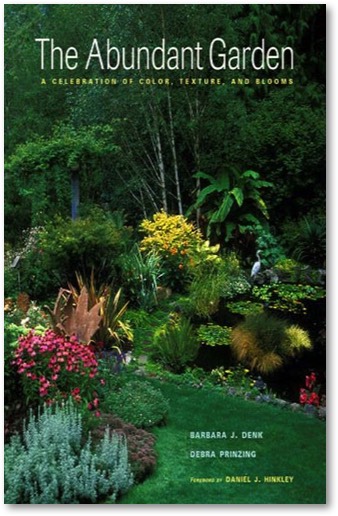
Musings » The Abundant Garden: a celebration of color, texture and blooms


Nashville, Tennessee
Cool Springs Press 2005
Of course gardens have to be full of color, texture and blooms. What else are they for? This seems to be a statement of the obvious but I doubt that two such skilled authors, and Daniel Hinkley, who wrote the foreword, would be satisfied with that. Yet, as soon as I wrote those challenging opening words an odd question came into my mind. What would I find if I took the opposite view: no color, no texture and no blooms? Is the answer “not a garden”? Well no, not exactly.
There are indeed amazing gardens with no color, no vegetative texture and no blooms: the Japanese Zen gardens. Right away we are catapulted into the midst of garden philosophy and the very definition of what constitutes a garden.
Now it is time to read the small print. The book sprang from close observation of nine beloved gardens in Washington State, emblematic of the “new Northwest landscape”. By “abundance” the authors mean rich planting in a thoughtful manner, more or less hiding the surface of the soil from view yet allowing some room for excitement and the unexpected. This is not an agricultural treatise in which an abundance of fruit and food is important.
In some ways the term means planting rather more than the space can hold. That leads to spillage over tight borders, giving an effect of spontaneity. Planning for surprise sounds a little like an oxymoron but one knows what they mean. Given adequate climate and soil nutrition, they indicate that most gardeners in the temperate regions could create such a place. The introductory section offers nine design principles as guidance.
Scale is important, also the techniques of ornamentation, color, patterns, layering and framed views. Christopher Lloyd was a master of these. Their other principles are a little less tangible and harder to reproduce. Movement, timelessness, spontaneity and intimacy are softer criteria. “Timelessness” means the effect of the garden seeming always to have been in its present state, almost inevitable. It can be a worthy goal but because of the paradoxes inherent in all gardens, by the time a garden is at that stage of ripe maturity it is necessary to prune it back and re-organize it before it collapses into an overgrown thicket.
In a number of the gardens the owners used driftwood or other warped and seasoned objects to provide contrast with the fluidity and spreading nature of the plants. My personal opinion is that this can be overdone, the intended frisson of the unexpected visual clash turning into a tiresome cliché.
Among the nine gardens presented here one in particular attracted me very much: the “textured tapestry” based on the extensive use of grasses. The landscape designer, Jay Fossett, had grown up helping his father install gardens designed by Wolfgang Oehme and James van Sweden. The property led down to the sea and Fossett fostered the movement of the eye to the horizon by undulating masses of grass. He is quite proud of taking much of his inspiration from Oehme and van Sweden.
Barbara Denk’s photographs are superb. They could stand on their own even without a text. Debra Prinzing supplies descriptions and comments as the gardens are disclosed. I am not sure that what they are telling us is especially new or different but it is a very beautiful book.

